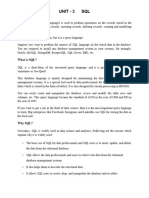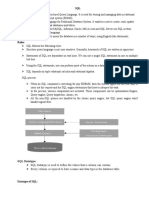0% found this document useful (0 votes)
170 views14 pagesIntroduction To SQL
SQL is a standard language for accessing and manipulating databases. It allows users to query data, insert, update, and delete records from databases. SQL statements are divided into data manipulation language to query and modify data, and data definition language to define and manage database structures like tables, indexes, and constraints. Key SQL statements include CREATE to build databases and tables, INSERT to add data, SELECT to query data, and UPDATE/DELETE to modify records.
Uploaded by
Gerome G. BulanCopyright
© © All Rights Reserved
We take content rights seriously. If you suspect this is your content, claim it here.
Available Formats
Download as PPTX, PDF, TXT or read online on Scribd
0% found this document useful (0 votes)
170 views14 pagesIntroduction To SQL
SQL is a standard language for accessing and manipulating databases. It allows users to query data, insert, update, and delete records from databases. SQL statements are divided into data manipulation language to query and modify data, and data definition language to define and manage database structures like tables, indexes, and constraints. Key SQL statements include CREATE to build databases and tables, INSERT to add data, SELECT to query data, and UPDATE/DELETE to modify records.
Uploaded by
Gerome G. BulanCopyright
© © All Rights Reserved
We take content rights seriously. If you suspect this is your content, claim it here.
Available Formats
Download as PPTX, PDF, TXT or read online on Scribd
/ 14

















































































